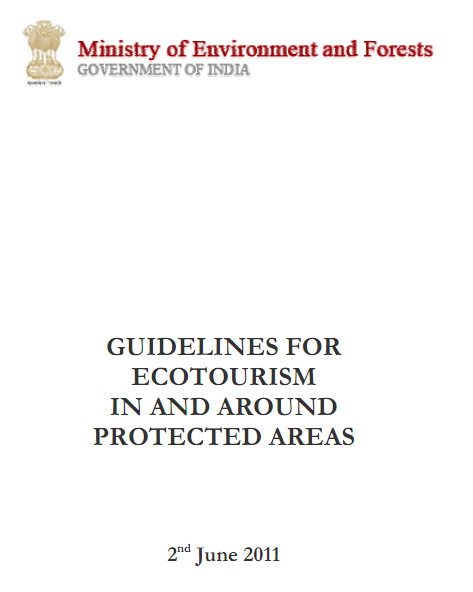India’s Ecotourism Guidelines (review) on draft version (2011 version)
 The Ministry of Environment & Forest (MoEF), Government of India took out the first draft version of India’s Ecotourism guidelines for in and around Protected Areas: The full report can be viewed on attachment. Report Ecotourism Guidelines Draft version
The Ministry of Environment & Forest (MoEF), Government of India took out the first draft version of India’s Ecotourism guidelines for in and around Protected Areas: The full report can be viewed on attachment. Report Ecotourism Guidelines Draft version
My comments (non Italic) are as follows:
Having gone through the draft version and I am not sure where to start as points laid out are very general and a lot more research needs to be put in to fine tune the real outcomes. Have tried to sum up points which can be taken on board for the draft version – recommendations as below:
(mentioned in the draft) 2.2.1 Each Protected Area must develop its own Ecotourism Plan, as part of its Tiger Conservation Plan, Management Plan, or Annual Plan of Operation, and should be duly approved by the Chief Wildlife Warden of the State, and the National Tiger Conservation Authority (where relevant). The plan should be consistent with the State Ecotourism Strategy and must be approved by the LAC and the State Government. An ecotourism plan for each PA must be notified by December 31, 2011, and put in the public domain, in the local language also.
The plan should:
ii) Assess carrying capacity of the Protected Area, at three levels: physical, real and effective/permissible carrying capacity of visitors and vehicles (See Annexure II) – More insight is needed to the current proposed Annexure II of calculating Carrying Capacity. There is no measurement of indicators focusing on Physical ecological Indicators (where high priority impact assessments on Natural Environment & Biodiversity, Air Quality, Noise pollution, Water, Cultural Heritage, Tourism Infrastructure & land) whereby only Land and Wildlife Disturbance has been taken by Annexure II. Second Indicator is Socio – Demographic Indicators (where again high priority impact assessment needs to be given on Demography, Tourist Flow & Psychological Issues) and the final indicator looks at Political – economic Indicator (this is where only high priority should be given to policy for tourism development).
iii) Set a ceiling level on number of visitors allowed to enter a Protected Area at any given time, based on the carrying capacity of the habitat –This is a very good point raised in the draft but a lot of stuff needs to be looked into in carrying out the relevant parameters here: This is where Limit of Acceptable Change research has to be looked into and should be in the Annexure II – Putting carrying capacity into practice and that’s where LAC is used as a model. Identifying when and where impacts occurs, the levels of impacts that are acceptable (I.e identify limits to accept change) and ensuring impacts remain in these bounds. The ceiling level mentioned here and the numbers of visitors allowed to enter should be balanced with the number of lodges mushrooming – lodges also need to have a cap on the number of beds allowed etc.
v) Develop a participatory community-based tourism strategy, in collaboration with local communities, to ensure long-term local-community benefit-sharing, and promotion of activities run by local communities – Very easy to say and difficult to implement. Scientifically it has been proven that community based tourism initiatives are not successful in high human density areas. Most of all out PAs are surrounded by high human habitation. This point will surely alienate many participants once it has been established. The best option here is to use village development schemes / involving village panchayat heads on decision making which can sustain projects for a longer run.
vi) Develop codes and standards for privately-operated tourist facilities located in the vicinity of core/critical wildlife habitats, eco-sensitive zones or buffer areas, with a view to, inter alia, ensure benefit and income to local communities – Tourism certification is something that should be high priority in wilderness area. This should involve all tourism supply chain stakeholders (International operators / domestic India travel operator and finally the accommodation provider). When we have guidelines / benchmarks we have standards to achieve and makes a lot of impacts settle in as we set indicators for the participants to achieve and follow. I am also in this belief that there should be only ‘ONE’ certifier as that sets the standards all over the wilderness trails. If we have thousand certifiers – there will be no specific standards existing to follow. In this both ministries (MoEF and MOT) should be stakeholders with an independent auditing scheme that works to improve India’s wilderness practices.
ix) Do’s and Don’ts for visitors (see Annexure I) – Very important for visitor education / awareness. Do’s and Don’t are very visitor unfriendly. Its still a very colonial way of letting visitors know what to do and don’ts. My suggestions here will be Responsible Guidelines and options of please ensure not to rather then Do’s and Don’t. Do’s and Don’t should only be applicable on advise given on the guidelines which should be law (I.e. Do not Poach)
Interesting to see, there is no mention of guiding in protected areas and that should be one of the major enhancements of India’s educative future.
——————
These are my concerns of the ecotourism guidelines. There are many other points which I wanted to recommend / raise from the draft, but I am sure other people may have raised already to policy makers. I personally hope to see a bright future for India’s ecotourism – where sustainability, education, awareness and research should be high priorities.
——————-











0 Comments